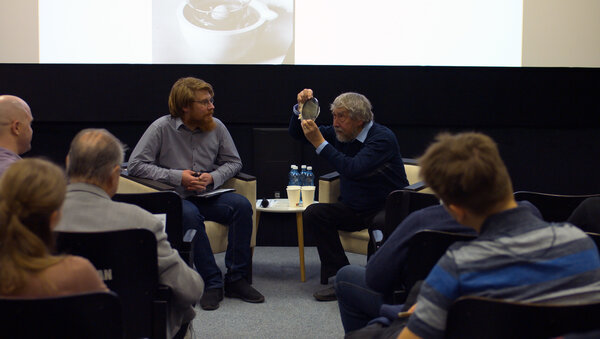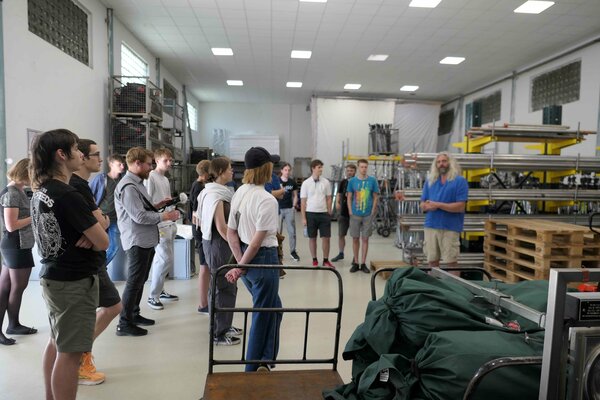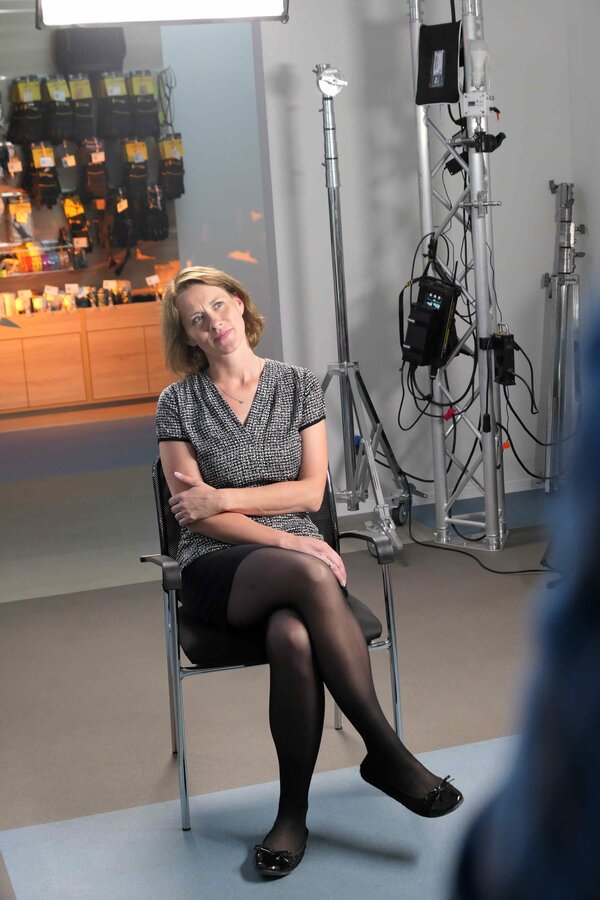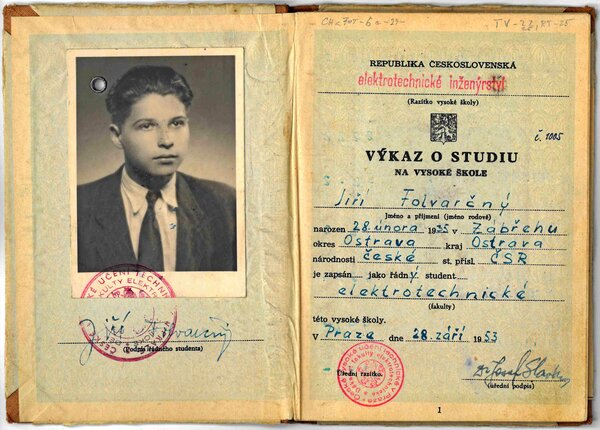To mark this important anniversary, the Department of Radioelectronics, in cooperation with the Methodological Centre for Digitization, Restoration, Archiving and Presentation of Images and Sound Recordings, is organizing a project "How to Make a Career in Audiovisual and Multimedia?" a series of workshops with graduates, current students, and high school students as well as follow-up guided tours to their future employers. The project aims to connect theory with practice, technology with creation, and the younger generation with experienced experts. You can listen to an excerpt from a unique recording of a lecture given by a radio technician and also a student of the Faculty of Mechanical and Electrical Engineering at the Department of Physics under the guidance of J. B. Slavik here. The excerpt was played at the first workshop in the cinema hall at SPŠST in Panská on 26 March 2024.
The establishment of the field of study at the Faculty of Electrical Engineering was made possible by several fortunate circumstances and strong personalities in 1954, including the then Dean of the Faculty and our leading acoustician Prof. Ing. RNDr. Josef Bartoloměj Slavík, the founder of the first republican Institute of High Frequency Electrical Engineering (later the Institute of Radio Engineering) and former Dean Prof. Ing. Josef Stránský; last but not least, the main initiator of the field, then still an associate professor, Ing. Zdeněk Holub. Three years earlier, he had already been entrusted, on the basis of the requirements of the Czechoslovak State Film and other branches of industry, with the management of the postgraduate two-semester course in Film Technology Teaching for university graduates in two areas: film and sound technology or the production and processing of cinematographic raw materials.
However, the history of practical film production at CTU is much older, and again at its beginnings stands Zdeněk Holub, who in 1940 pushed for the establishment of the Testing Electrotechnical Institute at the Protectorate Ministry of Education and National Enlightenment with the support of his mentor and director of the Institute of Theoretical and Experimental Electrical Engineering Prof. Ing. Ludvík Šimek, pioneer of wireless telegraphy and the first radiophonic experiments from the Petřín tower in 1918, which provided important political and military communication with Paris. The listeners' interest in the new communication medium was obvious, as explained in his report by Ing. František Kec in the Bulletin of the Masaryk Academy of Labour in 1930.
In the newly established institute, Holub concentrated a considerable amount of film and sound equipment from the property of Czech universities together with twenty-six employees of the closed CTU during the occupation, which enabled him to immediately after the liberation by the decision of the Ministry of Industry and Trade No. A-259241/46-V/2 of 31 December 1946, and with the consent of all faculties, to establish the Research Institute of Sound Technology and Films (VÚZTF), located at 5 Husova Street in Prague's Old Town, at the University of Mechanical and Electrical Engineering (the Prague FAMU had been established only a month earlier, on 28 November 1946).
However, the establishment of the Holub Institute was preceded by a competence dispute between the Ministry of Education and the Ministry of Information. With the adoption of the nationalization Decree of the President of the Republic on measures in the field of film on 28 August 1945, the right to shoot and further economically exploit "illuminated" films was reserved exclusively to the Czechoslovak State Film, but did not apply to films made "within the Ministry of National Defence and to amateur film". Since the fifth paragraph of the Decree, which was supposed to clarify the competence of the various ministries, was never adopted, the SCTF was also to serve all other universities as the guiding body for the shooting, distribution and archiving of scientific research, documentary, school and educational films. Thanks to the concentration of technology and the political agility of Associate Professor Holub, a paradoxical situation arose in which the first films were made at the CTU and even awarded at the 1947 International Film Festival in Paris a few months before the first school film, Searching for Spring, by students Evžen Drmola and Jiří Ployhar, was ever made at the Film Faculty of the Academy of Performing Arts in Prague.
But this is not the only first in the field of radio - film - television when the Faculty of Electrical Engineering overtook the famous FAMU in Prague. That is why this year we are organizing a series of unique workshops and guided tours to support and develop the study of Audiovisual Technology in Electrical Engineering and Communication. The first of them was held on 26 March 2024 in the cinema hall at SPŠST in Panská, in the sign of the combination of tradition with professionalism and innovation, featuring some of the first students of the field, who became famous in the country and in the world as a master of sound and winner of several Czech Lions ing. Ivo Špalj, or those such as the cinematographer Prof. Jaromír Šofr, who, thanks to the cooperation with the teachers of the oldest audiovisual field in Czechoslovakia at our alma mater, were able to use technical inventions and improvements in their own work, which helped them win awards at the most important domestic and foreign festivals. Prof. Jaromír Šofr, seated on the right in the photo, long-time head of the FAMU Department of Camera, explains to the moderator of the evening and organizer of the project for 70 years of the RFT field MgA. Miloslav Novák PhD. his invention.

The VÚZTF had a wide technical base, while FAMU, according to the memories of one of its three founders, Karol Plicka, had only one camera at its disposal, and the then Minister Jaroslav Stránský stopped the salaries of its teachers in 1947, so they had to teach for free. At the time of the legal independence of the Faculty of Electrical Engineering within the CTU on 1 January 1951, it was a single institute alongside eight other departments.
But we should not forget about the outstanding photographic image technician Prof. Dr. Ing. Jaroslav Bouček, another of the three founders of the Prague Film Faculty, alongside the then rector of the Academy of Performing Arts Antonín Martin Brousil. Bouček moved with his family from his native Brno to Prague at this time, and by the time he started teaching Radio, Film and Television in the 1954/1955 school year at the Czech Technical University, where he had been lecturing on photography from the beginning, he was already the dean of FAMU. He was also an exceptionally talented teacher and, according to the memories of Ján Kališ, later head of the Department of Camera, "in teaching, he worked with the method of representation, that is, slides, sketches, practical demonstrations of devices and cameras." Among other important teachers were such personalities as Dr. Jaroslav Pechar (optics and photometry), Dr. Jan Šlemr (photochemistry and laboratory technology), or even the emeritus technical advisor Ing. Alois Singer (television and radio), who already in the 1930s tried to establish electronic television at the Ministry of Posts and Telegraphs together with the technical director and co-founder of the radio company Radiojournal Ing. Eduard Svoboda, but their efforts were interrupted by the war.
It was the Czechoslovak Television, whose establishment was decided by the government on 8 April 1952, together with its then still organizationally superior unit, the Czechoslovak Radio, which together with the Czechoslovak State Film and Gramophone Works in Loděnice, were very keen on the establishment of regular university studies in the field of audiovisual engineering.
Another interesting event took place on 10 June 2024 in Hostivice under the title Become the Chief Lighting Engineer of Hollywood Films! During the unique workshop, Petr Konrád, the chief lighting designer of almost three dozen foreign big films and TV series, revealed theoretical and practical tips and tricks from his long career using lighting techniques to high school and bachelor students at FELU, using examples from his films and the final lighting of a pre-prepared scene, under his guidance, students could choose their own lighting equipment in the local showroom and rental shop, the largest of its kind in the country.



The first students of Radio, Film and Television entered the Faculty of Electrical Engineering in the joint Electrical Engineering programme in September 1952 (they included, for example, the later post-revolutionary director of Krátký film Ing. Jaroslav Karlicek), in which they began to specialise from the 3rd year in the winter semester of 1954. It was an extremely favourable year for the establishment of the new field: the start of regular television broadcasting in the Czechoslovakia, the rector was a pupil of Prof. Šimek and a pioneer of automation and Prof. Ing. Josef Trnka, the dean at the Faculty of Electrical Engineering was one of the key teachers Prof. Slavik, the dean at FAMU was another key teacher Prof. Boucek. In the third year, twelve two-semester courses, most of which were already fully disciplinary, formed the backbone of the studies. However, the students started their holidays with a one-month internship.
Study report from 28 September 1953 of the second course of RFT, Jiří Folvarčný, after graduation sound master at the Czechoslovak Radio in Ostrava, field specialist at the Central Directorate of Czechoslovak Film and technical deputy of Kinotechnika.

At present, the RFT is followed by the specialization Audiovisual Technology and Signal Processing, whose guarantor is the current Dean, Prof. Petr Páta, and which can be studied at the Faculty of Electrical Engineering as part of the Master's degree programme. Today, an attentive reader would probably not have enough time to count the number of university majors or specializations oriented on audiovisual and multimedia production or technology or the departments, institutes or centres of the same name at Czech universities with both hands. Therefore, we should be proud not only of the tradition of the oldest technically oriented audiovisual field in the country, but also of the professionalism that its graduates demonstrate in practice, not only in the technical but also in the creative field or how they apply themselves in management. The field has been undergoing innovation all along the way, which has manifested itself not only in teaching but also in research and development, which is currently thriving at the faculty. In addition, cinema has undergone a technological transformation, and so audiovisual engineers and their innovations are awaited by many memory institutions that need their cultural visual and audio heritage digitized, restored and made available to the public in the highest possible quality. The Methodological Centre for the Digitisation, Restoration, Archiving and Presentation of Visual and Audio Recordings seeks to cooperate with other leading institutions not only in this field and to share special techniques in the Archival Media Laboratory as an advisory, research, educational and promotional platform not only on technical and technological issues, but also on legal and cultural-historical ones.
MgA. Miloslav Novák DiS. et PhD.
Methodological Centre for Digitisation, Restoration, Archiving and Presentation
video and audio recordings

